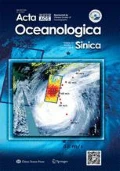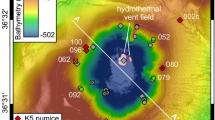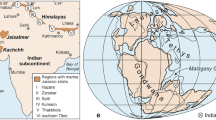Abstract
The late Quaternary shallow-water carbonates have been altered by a variety of diagenetic processes, and further influenced by high-amplitude global and regional sea level changes. This study utilizes a new borehole drilled on the Yongxing Island, Xisha Islands to investigate meteoric diagenetic alteration in the late Quaternary shallow-water carbonates. Petrographic, mineralogical, stable isotopic and elemental data provide new insights into the meteoric diagenetic processes of the reef limestone. The results show the variation in the distribution of aragonite, high-Mg calcite (HMC) and low-Mg calcite (LMC) divides the shallow-water carbonates in Core SSZK1 into three intervals, which are Unit I (31.20–55.92 m, LMC), Unit II (18.39–31.20 m, aragonite and LMC) and Unit III (upper 18.39 m of core, aragonite, LMC and HMC). Various degrees of meteoric diagenesis exist in the identified three units. The lowermost Unit I has suffered almost complete freshwater diagenesis, whereas the overlying Units II and III have undergone incompletely meteoric diagenesis. The amount of time that limestone has been in the freshwater diagenetic environment has the largest impact on the degree of meteoric diagenesis. Approximately four intact facies/water depth cycles are recognized. The cumulative depletion of elements such as strontium (Sr), sodium (Na) and sulphur (S) caused by duplicated meteoric diagenesis in the older reef sequences are distinguished from the younger reef sequences. This study provides a new record of meteoric diagenesis, which is well reflected by whole-rock mineralogy and geochemistry.
Similar content being viewed by others
References
Allan J R, Matthews R K. 1982. Isotope signatures associated with early meteoric diagenesis. Sedimentology, 29(6): 797–817, doi: https://doi.org/10.1111/j.1365-3091.1982.tb00085.x
Amirshahkarami M, Karavan M. 2015. Microfacies models and sequence stratigraphic architecture of the Oligocene-Miocene Qom Formation, south of Qom City, Iran. Geoscience Frontiers, 6(4): 593–604, doi: https://doi.org/10.1016/j.gsf.2014.08.004
Ayers J F, Vacher H L. 1986. Hydrogeology of an atoll island: a conceptual model from detailed study of a micronesian example. Groundwater, 24(2): 185–198, doi: https://doi.org/10.1111/j.1745-6584.1986.tb00994.x
Beach D K. 1995. Controls and effects of subaerial exposure on cementation and development of secondary porosity in the subsurface of Great Bahama Bank. In: Budd D A, Saller A H, Harris P M, eds. Unconformities and Porosity in Carbonate Strata. Tulsa, American: American Association of Petroleum Geologists, 1–15
Boggs S. 2009. Petrology of Sedimentary Rocks. 2nd ed. Cambridge: Cambridge University Press, 1–600
Buchbinder L G, Friedman G M. 1980. Vadose, phreatic, and marine diagenesis of Pleistocene-Holocene carbonates in a borehole; Mediterranean coast of Israel. Journal of Sedimentary Research, 50(2): 395–407
Budd D A, Land L S. 1990. Geochemical imprint of meteoric diagenesis in Holocene ooid sands, Schooner Cays, Bahamas; correlation of calcite cement geochemistry with extant groundwaters. Journal of Sedimentary Research, 60(3): 361–378
Cantalejo B, Pickering K T. 2014. Climate forcing of fine-grained deep-marine systems in an active tectonic setting: middle Eocene, Ainsa Basin, Spanish Pyrenees. Palaeogeography, Palaeoclimatology, Palaeoecology, 410: 351–371, doi: https://doi.org/10.1016/j.palaeo.2014.06.005
Cheng H, Edwards R L, Hoff J, et al. 2000. The half-lives of uranium-234 and thorium-230. Chemical Geology, 169(1–2): 17–33, doi: https://doi.org/10.1016/S0009-2541(99)00157-6
Coletti G, Basso D, Corselli C. 2018. Coralline algae as depth indicators in the Sommieres Basin (early Miocene, southern France). Geobios, 51(1): 15–30, doi: https://doi.org/10.1016/j.geobios.2017.12.002
Coyne M K, Jones B, Ford D. 2007. Highstands during Marine Isotope Stage 5: evidence from the Ironshore Formation of Grand Cayman, British West Indies. Quaternary Science Reviews, 26(3–4): 536–559, doi: https://doi.org/10.1016/j.quascirev.2006.06.013
Dang Haowen, Wang Tingting, Qiao Peijun, et al. 2019. The B/Ca and Cd/Ca of a subsurface-dwelling foraminifera Pulleniatina obliquiloculata in the tropical Indo-Pacific Ocean: implications for the subsurface carbonate chemistry estimation. Acta Oceanologica Sinica, 38(3): 138–150, doi: https://doi.org/10.1007/s13131-019-1406-6
Derry L A, Kaufman A J, Jacobsen S B. 1992. Sedimentary cycling and environmental change in the Late Proterozoic: evidence from stable and radiogenic isotopes. Geochimica et Cosmochimica Acta, 56(3): 1317–1329, doi: https://doi.org/10.1016/0016-7037(92)90064-P
Dickson J A D. 1985. Diagenesis of shallow-marine carbonates. In: Brenchley P J, Williams B P J, eds. Sedimentology Recent Developments and Applied Aspects. London: Geological Society, London, Special Publications, 173–188
Dunham R J. 1962. Classification of carbonate rocks according to depositional textures. In: Ham, W E, ed. Classification of Carbonate Rocks—A Symposium. Tulsa: AAPG, 108–121
Eberli G P. 2000. The record of Neogene sea-level changes in the prograding carbonates along the Bahamas Transect—Leg 166 Synthesis. In: Swart P K, Eberli G P, Malone M J, et al, eds. Proceedings of the Ocean Drilling Program, Scientific Results. 166: College Station, TX (Ocean Driling Program)
Embry III A F, Klovan J E. 1971. A late devonian reef tract on northeastern Banks Island, N.W.T.. Bulletin of Canadian Petroleum Geology, 19(4): 730–781
Fan Tianlai, Yu Kefu, Zhao Jianxin, et al. 2020. Strontium isotope stratigraphy and paleomagnetic age constraints on the evolution history of coral reef islands, northern South China Sea. GSA Bulletin, 132(3–4): 803–816, doi: https://doi.org/10.1130/B35088.1
Geel T. 2000. Recognition of stratigraphic sequences in carbonate platform and slope deposits: empirical models based on microfacies analysis of Palaeogene deposits in southeastern Spain. Palaeogeography, Palaeoclimatology, Palaeoecology, 155(3–4): 211–238, doi: https://doi.org/10.1016/S0031-0182(99)00117-0
Gill B C, Lyons T W, Frank T D. 2008. Behavior of carbonate-associated sulfate during meteoric diagenesis and implications for the sulfur isotope paleoproxy. Geochimica et Cosmochimica Acta, 72(19): 4699–4711, doi: https://doi.org/10.1016/j.gca.2008.07.001
Hajikazemi E, Al-Aasm I S, Coniglio M. 2010. Subaerial exposure and meteoric diagenesis of the Cenomanian-Turonian Upper Sarvak Formation, southwestern Iran. In: Leturmy P, Robin C, eds. Tectonic and Stratigraphic Evolution of Zagros and Makran during the Mesozoic-Cenozoic. London: Geological Society, London, Special Publications, 253–272
Harrison R S. 1975. Porosity in Pleistocene grainstones from Barbados: some preliminary observations. Bulletin of Canadian Petroleum Geology, 23(3): 383–392
Holail H. 1999. The isotopic composition and diagenetic history of pleistocene carbonates, North Qatar. Carbonates and Evaporites, 14(1): 41–45, doi: https://doi.org/10.1007/BF03176147
Hu Jianyu, Kawamura H, Hong Huasheng, et al. 2000. A review on the currents in the South China Sea: Seasonal circulation, South China Sea warm current and Kuroshio Intrusion. Journal of Oceanography, 56(6): 607–624, doi: https://doi.org/10.1023/A:1011117531252
Huang Xiaoxia, Betzler C, Wu Shiguo, et al. 2020. First documentation of seismic stratigraphy and depositional signatures of Zhongsha atoll (Macclesfield Bank), South China Sea. Marine and Petroleum Geology, 117: 104349, doi: https://doi.org/10.1016/j.marpetgeo.2020.104349
Jiang Wei, Yu Kefu, Fan Tianlai, et al. 2019. Coral reef carbonate record of the Pliocene-Pleistocene climate transition from an atoll in the South China Sea. Marine Geology, 411: 88–97, doi: https://doi.org/10.1016/j.margeo.2019.02.006
Kaufman A J, Jacobsen S B, Knoll A H. 1993. The Vendian record of Sr and C isotopic variations in seawater: implications for tectonics and paleoclimate. Earth and Planetary Science Letters, 120(3–4): 409–430, doi: https://doi.org/10.1016/0012-821X(93)90254-7
Kaufman A J, Knoll A H. 1995. Neoproterozoic variations in the C-isotopic composition of seawater: stratigraphic and biogeochemical implications. Precambrian Research, 73(1–4): 27–49, doi: https://doi.org/10.1016/0301-9268(94)00070-8
Kroeger K F, Reuter M, Brachert T C. 2006. Palaeoenvironmental reconstruction based on non-geniculate coralline red algal assemblages in Miocene limestone of central Crete. Facies, 52(3): 381–409, doi: https://doi.org/10.1007/s10347-006-0077-x
Ku T L, Mathieu G G, Knauss K G. 1977. Uranium in open ocean: concentration and isotopic composition. Deep Sea Research, 24(11): 1005–1017, doi: https://doi.org/10.1016/0146-6291(77)90571-9
Lei Yanli, Li Tiegang. 2016. Atlas of Benthic Foraminifera from China Seas the Bohai Sea and the Yellow Sea. Berlin Heidelberg: Springer-Verlag, 1–399
Li Rong, Qiao Peijun, Cui Yuchi, et al. 2018. Composition and diagenesis of Pleistocene aeolianites at Shidao, Xisha Islands: implications for palaeoceanography and palaeoclimate during the last glacial period. Palaeogeography, Palaeoclimatology, Palaeoecology, 490: 604–616, doi: https://doi.org/10.1016/j.palaeo.2017.11.049
Liao Zibo, Shao Qingfeng, Li Chunhua, et al. 2018. Measurement of U/Th isotopic compositions in stalagmites for 230Th/U geochronology using MC-ICP-MS by standard-sample bracketing method. Journal of Chinese Mass Spectrometry Society (in Chinese), 39(3): 295–309
Liu Jian, Han Chunrui, Wu Jianzheng, et al. 1998. Geochemical evidence for the meteoric diagenesis in Pleistocene reef limestones of Xisha islands. Acta Sedimentologica Sinica (in Chinese), 16(4): 71–77
Liu Na, Wang Zhenfeng, Li Xushen, et al. 2019. Reef-carbonate diagenesis in the Pleistocene-Holocene of the well Xike#1, Xisha Islands, South China Sea: implications on sea-level changes. Carbonates and Evaporites, 34(4): 1669–1687, doi: https://doi.org/10.1007/s13146-019-00515-1
Liu Jian, Ye Zhizheng, Han Chunrui, et al. 1997. Meteoric diagenesis in Pleistocene reef limestones of Xisha Islands, China. Journal of Asian Earth Sciences, 15(6): 465–476, doi: https://doi.org/10.1016/S0743-9547(97)00049-4
Lohmann K C. 1988. Geochemical patterns of meteoric diagenetic systems and their application to studies of paleokarst. In: James N P, Choquette P W, eds. Paleokarst. New York: Springer, 58–80
Ma Zhaoliang, Li Qianyu, Liu Xinyu, et al. 2018. Palaeoenvironmental significance of Miocene larger benthic foraminifera from the Xisha Islands, South China Sea. Palaeoworld, 27(1): 145–157, doi: https://doi.org/10.1016/j.palwor.2017.05.007
Ma Yubo, Wu Shiguo, Lv Fuliang, et al. 2011. Seismic characteristics and development of the Xisha carbonate platforms, northern margin of the South China Sea. Journal of Asian Earth Sciences, 40(3): 770–783, doi: https://doi.org/10.1016/j.jseaes.2010.11.003
Martin G D, Wilkinson B H, Lohmann K C. 1986. The role of skeletal porosity in aragonite neomorphism-Strombus and Montastrea from the Pleistocene Key Largo Limestone, Florida. Journal of Sedimentary Research, 56(2): 194–203
Matthews R K. 1968. Carbonate diagenesis: equilibration of sedimentary mineralogy to the subaerial environment; coral cap of barbados, West Indies. Journal of Sedimentary Research, 38(4): 1110–1119
Matthews R K, Frohlich C. 1987. Forward modeling of bank-margin carbonate diagenesis. Geology, 15(7): 673–676, doi: https://doi.org/10.1130/0091-7613(1987)15<673:FMOBCD>2.0.CO;2
McGregor H V, Gagan M K. 2003. Diagenesis and geochemistry of porites corals from Papua New Guinea: implications for paleoclimate reconstruction. Geochimica et Cosmochimica Acta, 67(12): 2147–2156, doi: https://doi.org/10.1016/S0016-7037(02)01050-5
Melim L A. 1996. Limitations on lowstand meteoric diagenesis in the Pliocene-Pleistocene of Florida and Great Bahama Bank: implications for eustatic sea-level models. Geology, 24(10): 893–896, doi: https://doi.org/10.1130/0091-7613(1996)024<0893:LOLMDI> 2.3.CO;2
Melim L A, Westphal H, Swart P K, et al. 2002. Questioning carbonate diagenetic paradigms: evidence from the Neogene of the Bahamas. Marine Geology, 185(1-2): 27–53, doi: https://doi.org/10.1016/S0025-3227(01)00289-4
Perry C T, Morgan K M, Salter M A. 2016. Sediment generation by Halimeda on atoll interior coral reefs of the southern Maldives: a census-based approach for estimating carbonate production by calcareous green algae. Sedimentary Geology, 346: 17–24, doi: https://doi.org/10.1016/j.sedgeo.2016.10.005
Quinn T M. 1991. Meteoric diagenesis of plio-pleistocene limestones at enewetak atoll. Journal of Sedimentary Research, 61(5): 681–703
Radtke U, Schellmann G. 2005. Timing and magnitude of sea level change during MIS 5 derived from barbados coral reef terraces: a critical literature review and New Data. Journal of Coastal Research, 21: 52–62
Raymo M E, Oppo D W, Curry W. 1997. The Mid-Pleistocene climate transition: a deep sea carbon isotopic perspective. Paleoceanography, 12(4): 546–559, doi: https://doi.org/10.1029/97PA01019
Robinson L F, Belshaw N S, Henderson G M. 2004. U and Th concentrations and isotope ratios in modern carbonates and waters from the Bahamas. Geochimica et Cosmochimica Acta, 68(8): 1777–1789, doi: https://doi.org/10.1016/j.gca.2003.10.005
Ruddiman W F, Raymo M E, Martinson D G, et al. 1989. Pleistocene evolution: northern hemisphere ice sheets and North Atlantic Ocean. Paleoceanography, 4(4): 353–412, doi: https://doi.org/10.1029/PA004i004p00353
Saller A H, Moore C H Jr. 1989. Meteoric diagenesis, marine diagenesis, and microporosity in Pleistocene and Oligocene limestones, Enewetak Atoll, Marshall Islands. Sedimentary Geology, 63(3–4): 253–272, doi: https://doi.org/10.1016/0037-0738(89)90135-8
Saller A H, Moore C H Jr. 1991. Geochemistry of meteoric calcite cements in some Pleistocene limestones. Sedimentology, 38(4): 601–621, doi: https://doi.org/10.1111/j.1365-3091.1991.tb01011.x
Shao Lei, Cui Yuchi, Qiao Peijun, et al. 2017a. Sea-level changes and carbonate platform evolution of the Xisha Islands (South China Sea) since the Early Miocene. Palaeogeography, Palaeoclimatology, Palaeoecology, 485: 504–516, doi: https://doi.org/10.1016/j.palaeo.2017.07.006
Shao Lei, Li Qianyu, Zhu Weilin, et al. 2017b. Neogene carbonate platform development in the NW South China Sea: litho-, bio- and chemo-stratigraphic evidence. Marine Geology, 385: 233–243, doi: https://doi.org/10.1016/j.margeo.2017.01.009
Sherman C E, Fletcher C H, Rubin K H. 1999. Marine and meteoric diagenesis of Pleistocene carbonates from a nearshore submarine terrace, Oahu, Hawaii. Journal of Sedimentary Research, 69(5): 1083–1097, doi: https://doi.org/10.2110/jsr.69.1083
Shi Xiaobin, Zhou Di, Qiu Xuelin, et al. 2002. Thermal and rheological structures of the Xisha Trough, South China Sea. Tectonophysics, 351(4): 285–300, doi: https://doi.org/10.1016/S0040-1951(02)00162-2
Sun Zhen, Stock J, Klaus A, et al. 2016. Expedition 367/368 scientific prospectus: South China Sea rifted margin. USA: International Ocean Discovery Program
Sun Zhen, Wang Zhenfeng, Sun Zhipeng, et al. 2015. Structure and kinematic analysis of the deepwater area of the Qiongdongnan Basin through a seismic interpretation and analogue modeling experiments. Acta Oceanologica Sinica, 34(4): 32–40, doi: https://doi.org/10.1007/s13131-015-0585-z
Sun Youbin, Yin Qiuzhen, Crucifix M, et al. 2019. Diverse manifestations of the mid-Pleistocene climate transition. Nature Communications, 10(1): 352, doi: https://doi.org/10.1038/s41467-018-08257-9
Suric M, Richards D A, Hoffmann D L, et al. 2009. Sea-level change during MIS 5a based on submerged speleothems from the eastern Adriatic Sea (Croatia). Marine Geology, 262(1-2): 62–67
Swart P K. 2015. The geochemistry of carbonate diagenesis: the past, present and future. Sedimentology, 62(5): 1233–1304, doi: https://doi.org/10.1111/sed.12205
Swart P K, Eberli G. 2005. The nature of the δ13C of periplatform sediments: implications for stratigraphy and the global carbon cycle. Sedimentary Geology, 175(1–4): 115–129, doi: https://doi.org/10.1016/j.sedgeo.2004.12.029
Swart P K, Hubbard J A E B. 1982. Uranium in scleractinian coral skeletons. Coral Reefs, 1(1): 13–19, doi: https://doi.org/10.1007/BF00286535
Swart P K, Oehlert A M, Mackenzie G J, et al. 2014. The fertilization of the Bahamas by Saharan dust: a trigger for carbonate precipitation?. Geology, 42(8): 671–674, doi: https://doi.org/10.1130/G35744.1
Taylor S R, McClennan S M. 1985. The Continental Crust: Its Composition and Evolution. United States: Blackwell Scientific Publications, 1–312
Tomás S, Homann M, Mutti M, et al. 2013. Alternation of microbial mounds and ooid shoals (Middle Jurasssic, Morocco): response to paleoenvironmental changes. Sedimentary Geology, 294: 68–82, doi: https://doi.org/10.1016/j.sedgeo.2013.05.008
Wang Zhenfeng, Huang Keke, Zhang Daojun, et al. 2018b. Maturation of neogene dolomite from xuande atoll of Xisha archipelago, the South China Sea. Marine and Petroleum Geology, 92: 51–64, doi: https://doi.org/10.1016/j.marpetgeo.2018.02.016
Wang Rui, Yu Kefu, Jones B, et al. 2018a. Evolution and development of Miocene “island dolostones” on Xisha Islands, South China Sea. Marine Geology, 406: 142–158, doi: https://doi.org/10.1016/j.margeo.2018.09.006
Webster J M, Braga J C, Clague D A, et al. 2009. Coral reef evolution on rapidly subsiding margins. Global and Planetary Change, 66(1-2): 129–148, doi: https://doi.org/10.1016/j.gloplacha.2008.07.010
Weinmann A E, Goldstein S T, Triantaphyllou M V, et al. 2019. Effects of sampling site, season, and substrate on foraminiferal assemblages grown from propagule banks from lagoon sediments of Corfu Island (Greece, Ionian Sea). PLoS One, 14(6): e0219015, doi: https://doi.org/10.1371/journal.pone.0219015
Wienberg C, Frank N, Mertens K N, et al. 2010. Glacial cold-water coral growth in the Gulf of Cádiz: implications of increased palaeo-productivity. Earth and Planetary Science Letters, 298(3–4): 405–416, doi: https://doi.org/10.1016/j.epsl.2010.08.017
Wu Shiguo, Chen Wanli, Huang Xiaoxia, et al. 2020. Facies model on the modern isolated carbonate platform in the Xisha Archipelago, South China Sea. Marine Geology, 425: 106203, doi: https://doi.org/10.1016/j.margeo.2020.106203
Wu Feng, Xie Xinong, Betzler C, et al. 2019. The impact of eustatic sea-level fluctuations, temperature variations and nutrient-level changes since the Pliocene on tropical carbonate platform (Xisha Islands, South China Sea). Palaeogeography, Palaeoclimatology, Palaeoecology, 514: 373–385, doi: https://doi.org/10.1016/j.palaeo.2018.10.013
Wu Shiguo, Yang Zhen, Wang Dawei, et al. 2014. Architecture, development and geological control of the Xisha carbonate platforms, northwestern South China Sea. Marine Geology, 350: 71–83, doi: https://doi.org/10.1016/j.margeo.2013.12.016
Wu Shiguo, Zhang Xinyuan, Yang Zhen, et al. 2016. Spatial and temporal evolution of Cenozoic carbonate platforms on the continental margins of the South China Sea: response to opening of the ocean basin. Interpretation, 4(3): SP1–SP19, doi: https://doi.org/10.1190/INT-2015-0162.1
Xu Shendong, Yu Kefu, Fan Tianlai, et al. 2019. Coral reef carbonate δ13C records from the northern South China Sea: a useful proxy for seawater δ13C and the carbon cycle over the past 1.8 Ma. Global and Planetary Change, 182: 103003, doi: https://doi.org/10.1016/j.gloplacha.2019.103003
Xu Hong, Zhao Xinwei, Eberli G P, et al. 2015. Biogenic carbonate formation and sedimentation in the Xisha Islands: evidences from living Halimeda. Acta Oceanologica Sinica, 34(4): 62–73, doi: https://doi.org/10.1007/s13131-015-0584-0
Yi Liang, Jian Zhimin, Liu Xinyu, et al. 2018. Astronomical tuning and magnetostratigraphy of Neogene biogenic reefs in Xisha Islands, South China Sea. Science Bulletin, 63(9): 564–573, doi: https://doi.org/10.1016/j.scib.2018.04.001
Zhao Yanyan, Li Sanzhong, Li Da, et al. 2019. Rare earth element geochemistry of carbonate and its paleoenvironmental implications. Geotectonica et Metallogenia (in Chinese), 43(1): 141–167
Acknowledgements
We thank the Institute of Hainan Marine Geological Survey for their assistance in gathering this data set throughout two cruises in 2015. Yanyan Zhao is thanked for the help during sample preparation and XRD analysis. Christian Betzler is acknowledged for his precious advices.
Author information
Authors and Affiliations
Corresponding authors
Additional information
Foundation item
The National Natural Science Foundation of China-Guangdong Joint Foundation under contract No. U1701245; the Hainan Provincial Natural Science Foundation of China under contract No. 418QN306; the Land and Georesource Bureau of Hainan Province under contract No. SQ2016KJHZ0027; the Pioneer Hundred Talents Program under contract No. Y910091001; the Guangzhou Marine Geological Survey Project under contract No. GZH201400210.
Rights and permissions
About this article
Cite this article
Chen, W., Huang, X., Wu, S. et al. Facies character and geochemical signature in the late Quaternary meteoric diagenetic carbonate succession at the Xisha Islands, South China Sea. Acta Oceanol. Sin. 40, 94–111 (2021). https://doi.org/10.1007/s13131-021-1713-6
Received:
Accepted:
Published:
Issue Date:
DOI: https://doi.org/10.1007/s13131-021-1713-6




